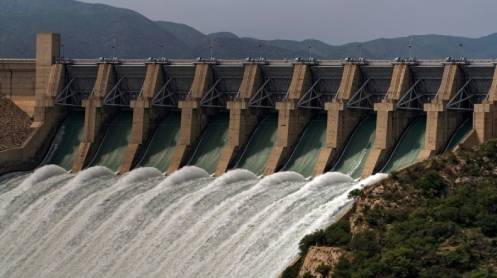LAHORE: The chances of Mangla Dam filling up to its optimum level have diminished following the Indus River System Authority’s (IRSA) inaction, an official said on Monday.
Punjab’s reliance on Mangla Dam for meeting its irrigation requirements have resulted in lesser water storage in the dam. Referring to an assessment made by the Punjab Irrigation Department, the official said that usually Jhelum River flow started increasing in mid-April, but abnormally cool weather in early to mid-summer months this year led to moderately low inflows.
Referring to the statistics till June 13, 2023, the provincial irrigation department said that the level of Mangla Dam is extremely low ie 1,139.30 feet while its expected level for this period was estimated by IRSA at 1,178.35 feet. This clearly shows that Mangla reservoir is 39.05 feet below its planned level.
As per estimates, dam should be at 80 percent of its capacity by late June, ensuring maximum level of 1,242 feet. However, against the inflow of 56,000 cusecs, 37,000 outflows were being maintained at Mangla from Jhelum River to divert it for irrigation purposes.
On the other hand, the level of Tarbela Dam has increased to 1,438.70 feet compared to the planned level of 1,436.28. Moreover, the inflow of water in Tarbela Dam has reached at a high level of 128,000 cusecs with only 65,000 cusecs being released.
In addition, the Meteorological Department has predicted increased inflows into the Indus River in the coming days. The need of the hour is to reduce the outflows from Mangala Dam, the official said.
Indus water release in greater quantities would help ensure running Panjand, TP Link and other canals off-taking from Trimmu and Taunsa Barrages and CJ Link from Chashma Barrage as per the indent of Punjab.
Expressing reservations about the distribution of river water at the federal level, the official added that the share of the province from the Tarbela Command should have been increased about two weeks back to deal with the extreme demand of Kharif crops amid hot weather.
Despite the clear improvement in the flow of the Indus River, IRSA did not raise water flows from Tarbela Command and failed to play its effective role as a regulator. “Due to this illogical and anti-Punjab attitude of IRSA, cotton and other standing crops are feared to be adversely affected,” they said.
Referring to statistics, the official said, “Punjab is being given only 10,000 cusecs out of 110,000 cusecs outflows from Indus arm, which is only nine percent, terming it completely unfair.”
Consequently, he claimed that the canals originating from Jinnah, Chashma and Taunsa barrages were running below capacity.
As a result, the shortage of water for agriculture in the western and southern parts of the province is increasing with each passing day. Due to the increase in demand, the production of cash crops like cotton and sugarcane, corn, rice are likely to be affected.
Punjab government has warned about its concerns through a letter and said that it is very important to release water from the Indus arm according to the share of the province in order to ensure filling of Mangala Dam as per plan.







